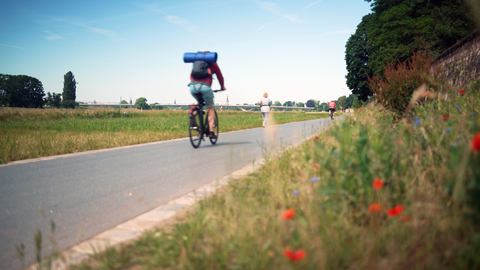25.09.2024
Wie wird Radfahren sicherer und attraktiver? »Gute Frage« über Fahrradforschung an der TU Dresden
Radfahren ist klimafreundlich und hält gesund. Doch damit mehr Menschen aufs Fahrrad steigen, muss es komfortabler und weniger gefährlich werden. Wie gelungene Infrastruktur für den Radverkehr aussieht und mit welchen Maßnahmen sich die Sicherheit für Radfahrende erhöhen lässt, erforschen Wissenschaftler:innen der TU Dresden.
In den Städten Münster und Oldenburg werden schon heute über 40 Prozent aller Wege bis 30 Kilometer mit dem Fahrrad bewältigt. „Das zeigt das hohe Potenzial des Fahrrads in der Stadt“, erklärt Professorin Regine Gerike in der »Guten Frage«. „Ein Großteil unserer Mobilität findet im Nahbereich statt und dafür ist das Fahrrad hervorragend geeignet.“ Abgesehen davon, dass Radverkehr im Vergleich zu motorisiertem Verkehr mit deutlich geringeren Treibhausemissionen verbunden ist, ist das Rad auf den kurzen Wegen oft sogar schneller als das Auto. Radverkehr hat noch einen weiteren positiven Effekt, weiß die Verkehrswissenschaftlerin: „Die Flächeneffizienz. Wenn wir mehr Menschen aufs Fahrrad bringen, können wir auch mehr Flächen umverteilen und so Räume für Aufenthalt, die Versickerung von Wasser oder die Vermeidung von Hitzeinseln schaffen.“
Wie wird Fahrradfahren sicherer & attraktiver? Gute Frage über Radverkehr © Videoteam TU Dresden
Radschnellwege, glatte Oberflächen und Lückenschlüsse: Was macht gelungene Radverkehrsinfrastruktur aus?
Damit mehr Menschen aufs Rad steigen, müssen auch die Voraussetzungen dafür geschaffen werden. Wie gute Infrastruktur für Radfahrende aussieht, wird an der TU Dresden mithilfe von Daten erforscht, die aus der Radfahrkampagne STADTRADELN gewonnen werden. Dabei tracken Radfahrende 21 Tage lang ihre alltäglichen Strecken über eine App – so wie aktuell noch bis zum 27. September in Dresden. Sven Lißner und Stefan Huber von der Professur für Verkehrsökologie werten diese Daten für ihre Forschungsprojekte aus. „Wir wissen, dass Radfahrende gut ausgebaute Radverkehrsinfrastruktur brauchen. Sie bevorzugen glatte Oberflächen, wünschen sich eine hohe Netzdichte und Lückenschlüsse“, erklärt Stefan Huber. Auch der Ausbau von Radschnellwegen sei ein wichtiger Faktor.

Neuer Radweg des Körnerwegs am Elbufer
Ein gutes Beispiel dafür stellt der Körnerweg am Elbufer zwischen Saloppe und Blauem Wunder dar. Als der historische Treidelpfad – ein Sandsteinpflaster mit großen Lücken – wegen einer Baumaßnahme mit einer provisorischen Asphaltdecke ausgestattet wurde, wirkte sich das auch auf den Fahrradverkehr aus. „Vorher kaum befahren, jetzt eine attraktive Routenalternative zur anderen Elbseite“, legt Sven Lißner dar. „Das zeigt so ein bisschen, was möglich ist.“ Inzwischen gibt es parallel zum alten Pfad einen neuen Radweg. Um Bedarfe besser identifizieren zu können und die Angebotsplanung von Städten und Kommunen zu unterstützen, entwickeln die Verkehrswissenschaftler:innen der TU Dresden eine Radverkehrssimulation. Während es für den PKW-Verkehr bereits gute Simulationen gibt, fehlt ein solches Tool für den Radverkehr. „Damit können künftig Maßnahmen und Wirkungen abgeschätzt und Ausbauprojekte priorisiert werden“, erklärt Stefan Huber.
Sicherheit beim Radfahren: Wie lassen sich Konflikte im Straßenverkehr reduzieren?
Neben schlechter Infrastruktur hält auch mangelnde Sicherheit Menschen davon ab, häufiger das Rad zu nutzen. „Radfahren ist nicht per se gefährlich. Das wird es erst durch die Interaktion mit anderen Verkehrsteilnehmenden – insbesondere mit Autos“, weiß Sebastian Hantschel, der an der Professur für Mobilitätssystemplanung zu Verkehrssicherheit im Rad- und Fußverkehr forscht. „Es geht darum, die Anzahl und die Intensität von Konflikten zwischen den Verkehrsteilnehmenden zu minimieren.“ Die Anzahl lasse sich durch separate und bestenfalls baulich getrennte Radverkehrsanlagen verringern, ergänzt Sebastian Hantschel. Wo das allerdings nicht möglich ist, könnten geringere Geschwindigkeitsdifferenzen das Unfallrisiko und Unfallschwere senken. „Je homogener der Verkehrsfluss ist, desto weniger Konflikte treten auf.“

Risiko für Fahrradfahrende: Rechtsabbiegende Autos
Klassische Schwerpunkte für Unfälle mit Fahrrädern sind Kreuzungen, speziell mit rechtsabbiegenden Autos, ein- und ausparkende Fahrzeuge sowie Gleise von Straßenbahnen. „Die non-plus-ultra Infrastruktur“, ergänzt Stefan Huber zum Thema Sicherheit, „sind breite Radwege, abgesichert gegen den fließenden Verkehr. So bekommt man mehr Menschen aufs Rad.“ Das wiederum trägt selbst zur Sicherheit bei. „Wenn mehr Menschen Rad fahren, sinkt das Risiko für den Einzelnen“, erklärt Sebastian Hantschel. Dabei handelt es sich um den „Safety in Numbers“-Effekt. Der besagt, dass Radfahrende in einer großen Gruppe weniger wahrscheinlich in einen Unfall verwickelt werden, als wenn sie allein unterwegs sind.
Sicher, schnell und komfortabel: So wird Radfahren attraktiver
„Radverkehr muss sicher, schnell und komfortabel werden“, fasst Stefan Huber zusammen. Gut ausgebaute und vor allem sichere Radwege sorgen dafür, dass Radfahren zur attraktiven Alternative zu anderen Verkehrsarten wird. „In unserer alltäglichen Mobilität ist der Radverkehr eine wichtige Säule für den Klimaschutz“, ist sich Verkehrswissenschaftlerin Regine Gerike sicher. Die Forschung mit den STADTRADLEN-Daten schafft Entscheidungsgrundlagen für die fahrradfreundliche Stadtplanung.
Mehr Einblicke in ihre Forschung zu Radverkehrsinfrastruktur und Sicherheit geben die Wissenschaftler:innen der TU Dresden in der aktuellen Folge des Videoformats »Gute Frage« auf dem YouTube-Kanal »TU Dresden entdecken«. Im Verkehrsmuseum Dresden wird darüber hinaus auch einen Blick in die Geschichte und auf die historische Bedeutung des Fahrrads geworfen. Auch das Forschungsprojekt ePredikt, welches das Ermüdungsverhalten bestimmter Bauteile bei E-Bikes untersucht, wird im Video vorgestellt.
Kontakte:
Prof. Regine Gerike
Professur für Mobilitätssystemplanung
Dr. Sebastian Hantschel
Professur für Mobilitätssystemplanung
